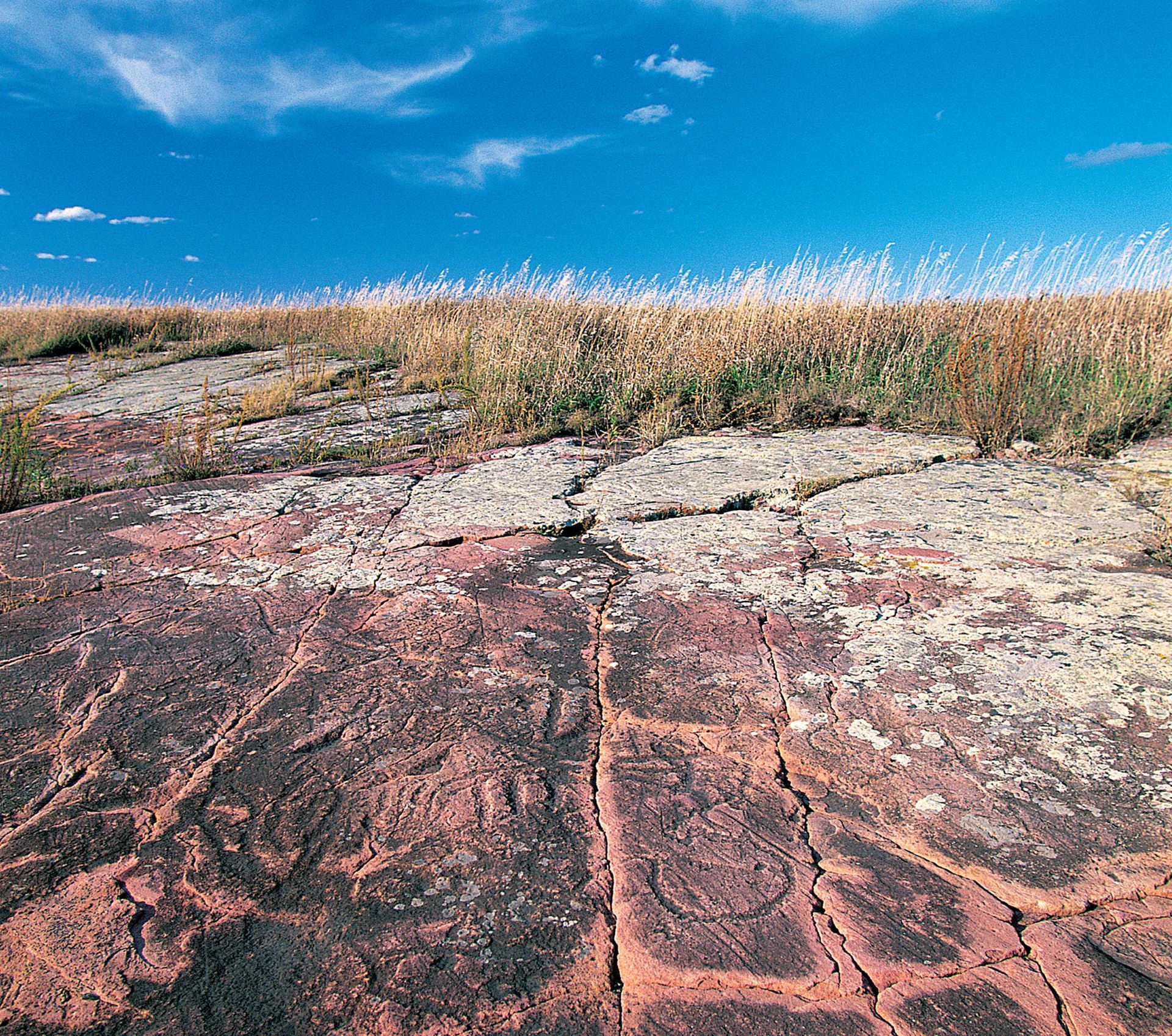by Louise Segreto
Sheltering myself from the biting January wind blowing across the flat expanse of what used to be endless native prairie, I crouch behind a huge Buffalo Rubbing Rock at Jeffers Petroglyphs. Jeffers Petroglyphs is located in southwestern Minnesota about 2.5 hours from the Twin Cities. Large rocks like this were used by buffalo to rub against to rid themselves of molting heavy winter coats and scratch irritating bug bites. The Rubbing Rock that I am leaning against is a huge glacial boulder, about 10 feet high, polished to a high sheen by the rubbing of countless American Plains Bison over the many years before they were driven to near extinction by the late 1800s. I grow somber thinking about the alarming rate that many other species across the globe are following the path of the buffalo towards extinction.
The Rubbing Rock stands as a steadfast reminder along a trail through a small restored prairie at Jeffers. This Rock looks as though it came from outer space, an erratic, dropped atop the horizontal outcropping of pink Sioux quartzite by retreating glaciers millions of years ago. Jeffers Petroglyphs is a part of the Minnesota Historical Society’s network of historic sites. The horizontal rock outcroppings inscribed with pictorial petroglyphs from pre-contact Native Americans earn Jeffers Petroglyphs its name.
Geologically striking places like Jeffers were deeply spiritual to Native Americans who believed that they were portals to the spiritual world. So, perhaps it is not surprising that I would feel haunted by the ghosts of the thunderous herds of Buffalo who once made these endless prairie lands of North America their home. I cannot help but think that there must be some deep wisdom to be learned from the spirit Buffalo as I sit huddled beside the Rock.
Let’s clear up some confusion: there is no difference in North America between the American Plains Bison, the name scientists prefer, and the more generic “buffalo”. It is the same animal. Within the proverbial historical blink of an eye, almost 10 million Buffalo were hunted and driven to near extinction starting in the 1600s when Native Americans began to hunt buffalo on horseback, followed by the push of early U.S. settlers on the east coast buffalo range, to the loss of grass land habitat caused by droughts, and the plow for farming. The final slaughter occurred after the Civil War when the rail-roads were developing and buffalo were slaughtered by the millions to meet European demand for hides and just hunted for wasteful sport. We obliterated the species.
Ironically, by the time President Theodore Roosevelt (determined to make U.S. coins more attractive) had the Buffalo/Indian Head nickel designed and minted between the years 1913-1938, the buffalo herds had disappeared and only about 1,000 buffalo are believed to have survived in the U.S. Adding further insult to injury, the buffalo image on the coin is reputed to have been modeled after a large ornery captive male buffalo named “Black Diamond” who resided at the Bronx Zoo in New York. Perhaps it is more historically accurate to regard the buffalo nickel as a “memorial token” to a species extinction.
If the Buffalo, such an iconic symbol of our Nation’s great American west, could be hunted to the brink of extinction, what hope do other much less noticeable and less charismatic animals have today under the federal Endangered Species Act (ESA)? And, with the Trump Administration’s assault on the ESA, there is even more reason to be disheartened. In the spring of 2018, there were no fewer than six Congressional bills pending aimed at gutting the protections of the ESA, ranging from undermining the scientific listing process of getting a species on the endangered species list to thwarting new listings based upon economic analysis based on projected losses to lumber, ranching, mining and other special interests. Nevertheless, we must not give up and lose hope. Environmental legislative battles are not won overnight; they are waged over many years. We Ikes are known for our tenacity to fight long term environmental wars. The spirit Buffalo urge us to remain vigilant about proposed changes to the ESA that weaken protections.
While the American Plains Bison is neither on the Federal Endangered Species list, nor Minnesota’s Endangered and Threatened Species Act, it is “ecologically extinct” meaning that the species can not exist on its own without assistance from man. Buffalo need prairie grasses to graze to survive. At one time prairie habitat covered about one-third of the Minnesota. Unfortunately, today, little more than 1% of Minnesota’s prairie exist in fragmented parcels.
Minnesota is proud to have approximately 140 Buffalo who are “wards of the State” in the Minnesota Bison Conservation Herd (MBCH). In 2012, the Minnesota DNR and Minnesota Zoo partnered together on establishing this Herd for the “public good”. The MBCH is an effort to maintain the high-quality genetics of at least the few remaining Buffalo survivors in Minnesota. It is managed at 3 different sites: Blue Mounds State Park, Minneopa State Park and the Minnesota Zoo. Additionally, a growing number of private landowners in Minnesota have begun to maintain small herds of Buffalo after learning about the benefit of buffalo to soil health and their important ecological role in the grassland environmental community.
We must never forget the plight of the Buffalo.
Images courtesy (from top) Minnesota Historical Society, Wikipedia, National Park Service.
